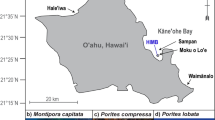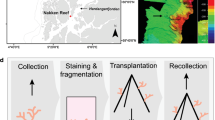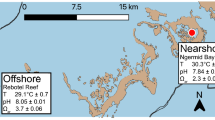Abstract
To evaluate potential coral adaptive mechanisms, we investigated physiological traits (biomass, lipid, protein, chlorophyll, and isotopic proxies for trophic strategy) in eight Hawaiian corals species along an environmental gradient of significant wave height, sea surface temperature, and seawater chlorophyll a concentration around the island of O‘ahu, Hawai‘i. We used the amount of physiological variation expressed in corals, and the proportion of this variation that could be explained by environmental variables, to construct hypotheses about the relative capacity for each species to adapt or acclimatize to differing conditions. Genus-level analyses indicated that Montipora and Pocillopora phenotypes are influenced more strongly by the environment than Porites corals. Species-level analyses revealed that Montipora capitata and Pocillopora acuta have the widest physiological niche boundaries, whereas Porites evermanni and Pocillopora meandrina are more physiologically restricted. Correlations between individual traits and the environmental gradient provided insight into potential adaptive mechanisms employed by each species that allow them to persist in reefs such as those within Kāne’ohe Bay, where water flow is lowest, and temperature, acidity, and nutrient concentrations are highest relative to other reefs around O‘ahu. Potential adaptive mechanisms included (a) increased surface-area-to-volume ratios to facilitate higher material flux across the diffusive boundary layer and/or to maximize light harvesting (M. capitata and P. acuta), (b) strategic investment of metabolic energy toward energy reserves (Montipora and Pocillopora), (c) changes in protein management likely via differential expression and function (Porites), and d) increased chlorophyll concentration per Symbiodiniaceae cell to maximize photosynthesis (Porites compressa). Comparison of our results with established patterns in the relative abundance of these species around O‘ahu suggests that species with wide physiological niche boundaries like M. capitata and M. flabellata might be expected to do better under predicted future ocean conditions and outcompete species such as P. evermanni and P. meandrina, making them potential candidates for coral conservation efforts.






Similar content being viewed by others
Data availability
The data analyzed for this study are deposited at BCO-DMO https://www.bco-dmo.org/project/546273
References
Anderson MJ (2006) Distance-based tests for homogeneity of multivariate dispersions. Biometrics 62:245–253
Anderson MJ (2008) A new method for non-parametric multivariate analysis of variance. Austral Ecol 26:32–46
Anderson MJ, Gorley RN, Clarke KR (2008) PERMANOVA + for PRIMER user manual. 1:1:218
Anthony KRN, Connolly SR (2004) Environmental limits to growth: Physiological niche boundaries of corals along turbidity-light gradients. Oecologia 141:373–384
Arinaga RA, Cheung KF (2012) Atlas of global wave energy from 10 years of reanalysis and hindcast data. Renew Energy 39:49–64
Bahr KD, Jokiel PL, Toonen RJ (2015) The unnatural history of Kāne’ohe bay: Coral reef resilience in the face of centuries of anthropogenic impacts. PeerJ 2015:e950
Barkley HC, Cohen AL, Golbuu Y, Starczak VR, DeCarlo TM, Shamberger KEF (2015) Changes in coral reef communities across a natural gradient in seawater pH. Sci Adv 1:1–8
Barshis DJ, Stillman JH, Gates RD, Toonen RJ, Smith LW, Birkeland C (2010) Protein expression and genetic structure of the coral Porites lobata in an environmentally extreme Samoan back reef: Does host genotype limit phenotypic plasticity? Mol Ecol 19:1705–1720
Bathen KH (1968) A descriptive study of the physical oceanography of Kaneohe Bay, Oahu,. Univ Hawaii Tech Rep No 14
Bradford MM (1976) A rapid and sensitive method for the quantification of microgram quantities of protein utilizing the principle of protein-dye binding. Anal Biochem 72:248–254
Brown BE (1997) Adaptations of reef corals to physical environmental stress. Advances in Marine Biology Vol. 3.
Chan N, Wangpraseurt D, Kühl M, Connolly SR (2016) Flow and coral morphology control coral surface pH: implications for the effects of ocean acidification. Front Mar Sci 3:10
Concepcion GT, Polato NR, Baums IB, Toonen RJ (2010) Development of microsatellite markers from four hawaiian corals: Acropora cytherea, Fungia scutaria, Montipora capitata and Porites lobata. Conserv Genet Resour 2:11–15
Conti-Jerpe IE, Thompson PD, Wong CWM, Oliveira NL, Duprey NN, Moynihan MA, Baker DM (2020) Trophic strategy and bleaching resistance in reef-building corals. Sci Adv 6:1–25
Cooper TF, Ulstrup KE (2009) Mesoscale variation in the photophysiology of the reef building coral Pocillopora damicornis along an environmental gradient. Estuar Coast Shelf Sci 83:186–196
Cooper TF, Ridd PV, Ulstrup KE, Humphrey C, Slivkoff M, Fabricius KE (2008) Temporal dynamics in coral bioindicators for water quality on coastal coral reefs of the Great Barrier Reef. Mar Freshw Res 59:703–716
Costanza R, de Groot R, Sutton P, van der Ploeg S, Anderson SJ, Kubiszewski I, Farber S, Turner RK (2014) Changes in the global value of ecosystem services. Glob Environ Chang 26:152–158
De Carlo EH, Hoover DJ, Young CW, Hoover RS, Mackenzie FT (2007) Impact of storm runoff from tropical watersheds on coastal water quality and productivity. Appl Geochemistry 22:1777–1797
Emery NC, Ewanchuk PJ, Bertness MD (2001) Competition and salt-marsh plant zonation: Stress tolerators may be dominant competitors. Ecology 82:2471–2485
Fabricius KE, Cooper TF, Humphrey C, Uthicke S, De’ath G, Davidson J, LeGrand H, Thompson A, Schaffelke B (2012) A bioindicator system for water quality on inshore coral reefs of the Great Barrier Reef. Mar Pollut Bull 65:320–332
Fox MD, Elliott Smith EA, Smith JE, Newsome SD (2019) Trophic plasticity in a common reef-building coral: insights from δ13C analysis of essential amino acids. Funct Ecol 33(11):2203–2214
Fisher R, O’Leary RA, Low-Choy S, Mengersen K, Knowlton N, Brainard RE, Caley MJ (2015) Species richness on coral reefs and the pursuit of convergent global estimates. Curr Biol 25:500–505
Fletcher CH, C. B, Conger CL, Engels MS, Al. E (2008) Geology of Hawaii reefs. In: Reigl B.M., Dodge R.E. (eds) Coral Reefs of the USA. Springer, New York,
Forsman ZH, Ritson-Williams R, Tisthammer KH, Knapp ISS, Toonen RJ (2020) Host-symbiont coevolution, cryptic structure, and bleaching susceptibility, in a coral species complex (Scleractinia; Poritidae). Sci Rep 10:1–12
Franklin EC, Jokiel PL, Donahue MJ (2013) Predictive modeling of coral distribution and abundance in the Hawaiian Islands. Mar Ecol Prog Ser 481:121–132
Garrison T (2013) Oceanography - An Invitation to Marine Science. Brooks/Cole, Belmont, CA, USA
Gorospe KD, Karl SA (2013) Genetic relatedness does not retain spatial pattern across multiple spatial scales: Dispersal and colonization in the coral, Pocillopora damicornis. Mol Ecol 22:3721–3736
Gorospe KD, Donahue MJ, Karl SA (2015) The importance of sampling design: spatial patterns and clonality in estimating the genetic diversity of coral reefs. Mar Biol 162:917–928
Grottoli AG, Rodrigues LJ, Juarez C (2004) Lipids and stable carbon isotopes in two species of Hawaiian corals, Porites compressa and Montipora verrucosa, following a bleaching event. Mar Biol 145:621–631
Grottoli AG, Tchernov D, Winters G (2017) Physiological and biogeochemical responses of super-corals to thermal stress from the northern gulf of Aqaba, Red Sea. Front Mar Sci 4:1–12
Guadayol Ò, Silbiger NJ, Donahue MJ, Thomas FIM (2014) Patterns in temporal variability of temperature, oxygen and pH along an environmental gradient in a coral reef. PLoS One 9:
Guest JR, Edmunds PJ, Gates RD, Kuffner IB, Brown EK, Rodgers KS, Jokiel PL, Ruzicka RR, Colella MA, Miller J, Atkinson A, Feeley MW, Rogers CS (2018) Time-series coral-cover data from Hawaii, Florida, Mo’orea, and the Virgin Islands: U.S. Geological Survey data release.
Hoegh-Guldberg O (2015) Reviving the Ocean Economy: the case for action - 2015. WWF Int
Hughes TP, Baird AH, Bellwood DR, Card M, Connolly SR, Folke C, Grosberg R, Hoegh-Guldberg O, Jackson JBC, Kleypas J, Lough JM, Marshall PA, Nyström M, Palumbi SR, Pandolfi JM, Rosen B, Roughgarden J (2003) Climate change, human impacts, and the resilience of coral reefs. Science (80- ) 301:929–933
Hughes AD, Grottoli AG, Pease TK, Matsui Y (2010) Acquisition and assimilation of carbon in non-bleached and bleached corals. Mar Ecol Prog Ser 420:91–101
Jeffrey SW, Humphrey GF (1975) New spectrophotometric equations for determining chlorophylls a, b, c1 and c2 in higher plants, algae and natural phytoplankton. Biochem und Physiol der Pflanz 167:191–194
Johnston EC, Forsman ZH, Toonen RJ (2018) A simple molecular technique for distinguishing species reveals frequent misidentification of Hawaiian corals in the genus Pocillopora. PeerJ 2018:1–14
Jokiel PL (1978) Effects of water motion on reef corals. J Exp Mar Bio Ecol 35:87–97
Jury CP, Toonen RJ (2019) Adaptive responses and local stressor mitigation drive coral resilience in warmer, more acidic oceans. Proc R Soc B Biol Sci 286
Jury CP, Delano MN, Toonen RJ (2019) High heritability of coral calcification rates and evolutionary potential under ocean acidification. Sci Rep 9:1–13
Kenkel CD, Matz M (2017) Gene expression plasticity as a mechanism of coral adaptation to a variable environment. Nat Ecol Evol 1:1–6
Legendre P, Anderson MJ (1999) Distance-based redundancy analysis: Testing multispecies responses in multifactorial ecological experiments. Ecol Monogr 69:1–24
Levas SJ, Grottoli AG, Hughes AD, Osburn CL, Matsui Y (2013) Physiological and biogeochemical traits of bleaching and recovery in the mounding species of coral Porites lobata: implications for resilience in mounding corals. PLoS One 8:e63267
Levas SJ, Grottoli AG, Warner ME, Cai WJ, Bauer JE, Schoepf V, Baumann JH, Matsui Y, Gearing C, Melman TF, Hoadley KD, Pettay DT, Hu X, Li Q, Xu H, Wang Y (2015) Organic carbon fluxes mediated by corals at elevated pCO2 and temperature. Mar Ecol Prog Ser 519:153–164
Lowe RJ, Falter JL, Monismith SG, Atkinson MJ (2009a) A numerical study of circulation in a coastal reef-lagoon system. J Geophys Res Ocean 114:1–18
Lowe RJ, Falter JL, Monismith SG, Atkinson MJ (2009b) Wave-driven circulation of a coastal reef-lagoon system. J Phys Oceanogr 39:873–893
Loya Y, Sakai K, Yamazato K, Nakano Y, Sambali H, van Woesik R (2001) Coral bleaching: The winners and the losers. Ecol Lett 4:122–131
McLachlan RH, Grottoli AG (2021) Geometric Method for Estimating Coral Surface Area Using Image Analysis. Protocols.io
McLachlan RH, Price JT, Solomon SL, Grottoli AG (2020a) Thirty years of coral heat-stress experiments: a review of methods. Coral Reefs 39:885–902
McLachlan RH, Dobson KL, Grottoli AG (2020b) Quantification of total biomass in ground coral samples. Protocols.io
McLachlan RH, Muñoz-Garcia A, Grottoli AG (2020c) Extraction of total soluble lipid from ground coral samples. Protocols.io
McLachlan RH, Price JT, Dobson KL, Weisleder N, Grottoli AG (2020d) Microplate assay for quantification of soluble protein in ground coral samples. Protocols.io
Moberg F, Folke C (1999) Ecological goods and services of coral reef ecosystems. Ecol Econ 29:215–233
Muscatine L, Porter JW, Kaplan IR (1989) Resource partitioning by reef corals as determined from stable isotope composition - I. δ13C of zooxanthellae and animal tissue vs depth. Mar Biol 100:185–193
Nakamura T, van Woesik R (2001) Water-flow rates and passive diffusion partially explain differential survival of corals during the 1998 bleaching event. Mar Ecol Prog Ser 212:301–304
Naumann MS, Niggl W, Laforsch C, Glaser C, Wild C (2009) Coral surface area quantification-evaluation of established techniques by comparison with computer tomography. Coral Reefs 28:109–117
Palardy JE, Rodrigues LJ, Grottoli AG (2008) The importance of zooplankton to the daily metabolic carbon requirements of healthy and bleached corals at two depths. J Exp Mar Bio Ecol 367:180–188
Pearse AS (1923) Animal Ecology. McGraw-Hill Book Company, New York
Price JT, Smith A, Dobson KL, Grottoli AG (2020) Airbrushed coral sample preparation for organic stable carbon and nitrogen isotope analyses. Protocols.io
Price JT, McLachlan RH, Jury CP, Toonen RJ, Grottoli AG (2021) Isotopic approaches to estimating the contribution of heterotrophic sources to Hawaiian corals. Limnol Oceanogr 66(6):2393–2407
Qin Z, Yu K, Wang Y, Xu L, Huang X, Chen B, Li Y, Wang W, Pan Z (2019) Spatial and intergeneric variation in physiological indicators of corals in the South China Sea: insights into their current state and their adaptability to environmental stress. J Geophys Res Ocean 3317–3332
R Core Team (2020) R: a language and environment for statistical computing. R Foundation for Statistical Computing, Vienna, Austria. https://www.R-project.org/
Richmond RH, Jokiel PL (1984) Lunar periodicity in larva release in the reef coral Pocillopora damicornis at Enewetak and Hawaii. Bull Mar Sci 34:280–287
Ringuet S, Mackenzie FT (2005) Controls on nutrient and phytoplankton dynamics during normal flow and storm runoff conditions, southern Kaneohe Bay, Hawaii. Estuaries 28:327–337
Rodrigues LJ, Grottoli AG (2006) Calcification rate and the stable carbon, oxygen, and nitrogen isotopes in the skeleton, host tissue, and zooxanthellae of bleached and recovering Hawaiian corals. Geochim Cosmochim Acta 70:2781–2789
Rodrigues LJ, Grottoli AG (2007) Energy reserves and metabolism as indicators of coral recovery from bleaching. Limnol Oceanogr 52:1874–1882
Sawall Y, Al-Sofyani A, Banguera-Hinestroza E, Voolstra CR (2014) Spatio-temporal analyses of Symbiodinium physiology of the coral Pocillopora verrucosa along large-scale nutrient and temperature gradients in the Red Sea. PLoS One 9:e103179
Sawall Y, Al-Sofyani A, Hohn S, Banguera-Hinestroza E, Voolstra CR, Wahl M (2015) Extensive phenotypic plasticity of a Red Sea coral over a strong latitudinal temperature gradient suggests limited acclimatization potential to warming. Sci Rep 5:e8940
Schoepf V, Cornwall CE, Pfeifer SM, Carrion SA, Alessi C, Comeau S, McCulloch MT (2018) Impacts of coral bleaching on pH and oxygen gradients across the coral concentration boundary layer: a microsensor study. Coral Reefs 37(4):1169–1180
Schoepf V, Grottoli AG, Warner ME, Cai WJ, Melman TF, Hoadley KD, Pettay DT, Hu X, Li Q, Xu H, Wang Y, Matsui Y, Baumann JH (2013) Coral energy reserves and calcification in a high-CO2 world at two temperatures. PLoS One 8:e75049
Schoepf V, Grottoli AG, Levas SJ, Aschaffenburg MD, Baumann JH, Matsui Y, Warner ME (2015) Annual coral bleaching and the long-term recovery capacity of coral. Proc R Soc B Biol Sci 282:e20151887
Silbiger NJ, Guadayol Ò, Thomas FIM, Donahue MJ (2014) Reefs shift from net accretion to net erosion along a natural environmental gradient. Mar Ecol Prog Ser 515:33–44
Smith LW, Barshis DJ, Birkeland C (2007) Phenotypic plasticity for skeletal growth, density and calcification of Porites lobata in response to habitat type. Coral Reefs 26:559–567
Somero GN (2012) The physiology of global change: linking patterns to mechanisms. Ann Rev Mar Sci 4:39–61
Spicer JI, Gaston KJ (1999) Physiological Diversity. Blackwell Science, Oxford, UK
Storlazzi CD, Brown EK, Field ME, Rodgers KS, Jokiel PL (2005) A model for wave control on coral breakage and species distribution in the Hawaiian Islands. Coral Reefs 24:43–55
Thornhill DJ, Rotjan RD, Todd BD, Chilcoat GC, Iglesias-Prieto R, Kemp DW, LaJeunesse TC, Reynolds JMC, Schmidt GW, Shannon T, Warner ME, Fitt WK (2011) A connection between colony biomass and death in Caribbean reef-building corals. PLoS One 6:e29535
Tisthammer KH, Forsman ZH, Toonen RJ, Richmond RH (2020) Genetic structure is stronger across human-impacted habitats than among islands in the coral Porites lobata. PeerJ 2020:0–24
Veron JEN (1995) Corals in space and time: the biogeography and evolution of the Scleractinia. Cornell University Press, Ithica, NY
Willis BL (1985) Phenotypic plasticity versus phenotypic stability in the reef corals Turbinaria mesenterina and Pavona cactus. Proc 5th Int Coral Reef Symp 4:
Ziegler M, Roder CM, Bchel C, Voolstra CR (2015a) Niche acclimatization in Red Sea corals is dependent on flexibility of host-symbiont association. Mar Ecol Prog Ser 533:163–176
Ziegler M, Roder CM, Büchel C, Voolstra CR (2015b) Mesophotic coral depth acclimatization is a function of host-specific symbiont physiology. Front Mar Sci 2:1–10
Acknowledgements
The authors would like to thank J Altschuler, J Armstrong, A Arribas, L Bailey, C Criswell, S Dixon, K Dobson, K Giesy, F Hawkes, H Hayes, A Huber, C Juracka, E Kline, S Lannon, M Locatis, A Moore, M Moran, C Mortemore, L Mullins, B Nainiger, E Nguyen, Y Noggle, E O’Flynn, M Otto, K Rockwell, K Ryan, E Sambuco, A Smith, K Snyder, S Solomon, J Walters, and A Wertz for assistance with laboratory and computer analyses.
Funding
AGG obtained major funding for this research from the National Science Foundation OCE Division of Ocean Sciences (award number: 1459536). Additional support to AGG came from the HW Hoover Foundation and the National Science Foundation OCE Division of Ocean Sciences (award number 1838667) and to CPJ and RJT from UH Sea Grant (award number 2180), the National Science Foundation Ocean Acidification Program (award number: OA-1416889), and OCE Division of Ocean Sciences (award number: 1514861). RHM obtained funding for sample analyses from Sigma Xi—The Scientific Honor Society (National and Ohio State Chapter Awards).
Author information
Authors and Affiliations
Contributions
AGG, CPJ, and RJT conceived of the study, wrote proposals, and secured funding. AGG and RJT supervised the study; CPJ collected samples; RHM and JTP performed the laboratory analyses; JTP performed stable isotope analyses; NW and AMG assisted with method development and facilitated use of laboratory equipment; RHM conducted the data analysis and wrote the manuscript. All authors contributed critically to drafts and gave final approval for publication.
Corresponding author
Ethics declarations
Conflict of interest
The authors declare that they have no conflict of interest.
Ethical approval
Samples were collected under State of Hawai‘i Department of Land & Natural Resources Division of Aquatic Resources Special Activity Permit (SAP) #2015–48.
Additional information
Publisher's Note
Springer Nature remains neutral with regard to jurisdictional claims in published maps and institutional affiliations.
Topic Editor Mark Vermeij
Supplementary Information
Below is the link to the electronic supplementary material.
Rights and permissions
About this article
Cite this article
McLachlan, R.H., Price, J.T., Muñoz-Garcia, A. et al. Environmental gradients drive physiological variation in Hawaiian corals. Coral Reefs 40, 1505–1523 (2021). https://doi.org/10.1007/s00338-021-02140-8
Received:
Accepted:
Published:
Issue Date:
DOI: https://doi.org/10.1007/s00338-021-02140-8




